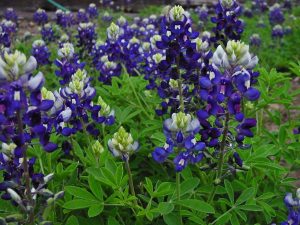 The story has it that when Egypt’s founding Great Lady entered the Nile valley she took up growing plants in the rich soil deposited by the annual spring floods. Prosperity followed and mixed with the one-upmanship urge of Egyptians gardeners.
The story has it that when Egypt’s founding Great Lady entered the Nile valley she took up growing plants in the rich soil deposited by the annual spring floods. Prosperity followed and mixed with the one-upmanship urge of Egyptians gardeners.
The Lady’s son, named Pharoah, dispatched plant hunters far and wide to bring back appealing flowering herbs, shrubs, and trees that would survive at home in east Africa. As a result this famous pyramid-building civilization’s lesser-known invention was flower gardening.
Well, don’t underestimate competitive North Texas that snuggles in same latitude of the earth’s temperate climate zone as ancient Egypt. If that’s not enough, we even hug the east edge of a desert. Okay, we don’t have the annual Nile flooding that redeposits alluvial soil for our growing pleasure. That’s why The Almighty gave us soil improvement programs.
Our middling planetary region’s weather and varying geography does means one size does not fit all the plants that can grow from El Paso to Texarkana and Amarillo to Brownsville.
Take, for example, apple trees also known as malus domestica. North Texas gardeners need to choose trees that produce fruits with light “pink” blushing skins. Those malus varieties require a low number of annual chilling hours or a short winter each year in order to bear a bushel of Mother Nature’s fruity treat. Good luck if you buy a sapling malus that will produce deep red Winesaps that flourish in Washington state for a chilly good reason.
With our climate in mind, modern cowboy plant hunters and breeders at the Texas Department of Agriculture have a research program to find and develop flowering plants, fruits, and vegetables they call Texas Superstars. Every variety of Superstar plant has survived several years of tough field trials by an A&M AgriLife research team, and has shown superior performance under Texas’ own tough temperate growing conditions. Next time you cruise the plant nursery aisles looking for some garden color or flavor, look for the Texas Superstar label to get proven winners.
Now’s a great time to think about what you want to put in next year’s flower beds. Annuals include Angelonia Serenas, Whopper Begonias, iconic Texas Bluebonnets (that also come in maroon), Gomphrenas, several petunias, Vinca Coras that floor everyone who sees one in bloom, a number of Hibiscus varieties, some Lantanas, and Turk’s Cap which I have found to be perennial verging on thuggish.
If you want to try out tropicals that will probably only last one season here, look for sassy stuff like Brazilian Red Hots, Pride of Barbados Caesalpinias, Gold Star Esperanza, and Firecracker Jatrophas among others.
Several roses, including Knock Outs, have become Texas Superstars, but don’t buy until you are sure the specimens for sale are not infected with the dreaded Rose Rosette Disease.
For variety look for Texas Gold columbines, John Fannick phlox, Henry Duelberg iridescent dark purple salvias and their gorgeous bridal white match August Duelberg salvias, Blue Princess verbenas, yarrows, butterfly weeds, ox-eye daisies (the true Texans in the daisy family), purple coneflowers, red yuccas, and scarlet sage. If you have space think about a crinum lily or two.
Check out lists of trees, grapes, and garden fruits and vegetables at www.texassuperstar.com. If you don’t see Texas Superstars on sale where you buy plants, ask for them by name.
(Contact the writer at noellemhood@gmail.com)





![LBJ bluebonnet50[1]](https://www.crosstimbersgazette.com/crosstimbersgazette/wp-content/uploads/2020/12/LBJ-bluebonnet501-696x522.jpg)






